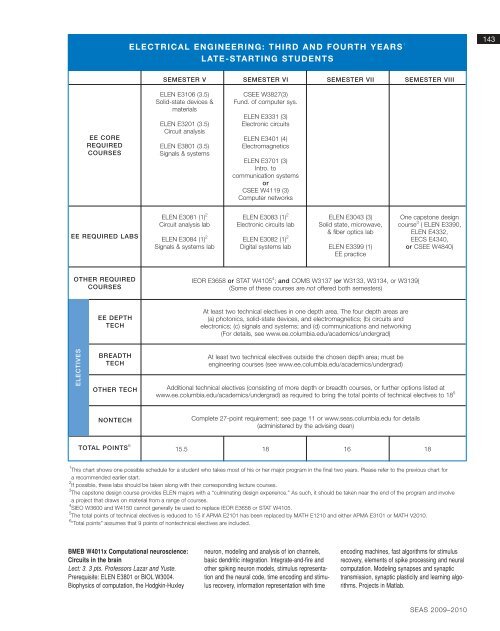2009-2010 Bulletin â PDF - SEAS Bulletin - Columbia University
2009-2010 Bulletin â PDF - SEAS Bulletin - Columbia University
2009-2010 Bulletin â PDF - SEAS Bulletin - Columbia University
Create successful ePaper yourself
Turn your PDF publications into a flip-book with our unique Google optimized e-Paper software.
ELECTRICAL ENGINEERING: THIRD AND FOURTH YEARS 1<br />
LATE-STARTING STUDENTS<br />
143<br />
SEMESTER V SEMESTER VI SEMESTER VII SEMESTER VIII<br />
EE CORE<br />
REQUIRED<br />
COURSES<br />
ELEN E3106 (3.5)<br />
Solid-state devices &<br />
materials<br />
ELEN E3201 (3.5)<br />
Circuit analysis<br />
ELEN E3801 (3.5)<br />
Signals & systems<br />
CSEE W3827(3)<br />
Fund. of computer sys.<br />
ELEN E3331 (3)<br />
Electronic circuits<br />
ELEN E3401 (4)<br />
Electromagnetics<br />
ELEN E3701 (3)<br />
Intro. to<br />
communication systems<br />
or<br />
CSEE W4119 (3)<br />
Computer networks<br />
EE REQUIRED LABS<br />
ELEN E3081 (1) 2 ELEN E3083 (1) 2 ELEN E3043 (3) One capstone design<br />
Circuit analysis lab Electronic circuits lab Solid state, microwave, course 3 ( ELEN E3390,<br />
& fiber optics lab ELEN E4332,<br />
ELEN E3084 (1) 2 ELEN E3082 (1) 2 EECS E4340,<br />
Signals & systems lab Digital systems lab ELEN E3399 (1) or CSEE W4840)<br />
EE practice<br />
OTHER REQUIRED<br />
COURSES<br />
IEOR E3658 or STAT W4105 4 ; and COMS W3137 (or W3133, W3134, or W3139)<br />
(Some of these courses are not offered both semesters)<br />
EE DEPTH<br />
TECH<br />
At least two technical electives in one depth area. The four depth areas are<br />
(a) photonics, solid-state devices, and electromagnetics; (b) circuits and<br />
electronics; (c) signals and systems; and (d) communications and networking<br />
(For details, see www.ee.columbia.edu/academics/undergrad)<br />
ELECTIVES<br />
BREADTH<br />
TECH<br />
OTHER TECH<br />
At least two technical electives outside the chosen depth area; must be<br />
engineering courses (see www.ee.columbia.edu/academics/undergrad)<br />
Additional technical electives (consisting of more depth or breadth courses, or further options listed at<br />
www.ee.columbia.edu/academics/undergrad) as required to bring the total points of technical electives to 18 5<br />
NONTECH<br />
Complete 27-point requirement; see page 11 or www.seas.columbia.edu for details<br />
(administered by the advising dean)<br />
TOTAL POINTS 6<br />
15.5 18 16 18<br />
1 This chart shows one possible schedule for a student who takes most of his or her major program in the final two years. Please refer to the previous chart for<br />
a recommended earlier start.<br />
2 If possible, these labs should be taken along with their corresponding lecture courses.<br />
3 The capstone design course provides ELEN majors with a “culminating design experience.” As such, it should be taken near the end of the program and involve<br />
a project that draws on material from a range of courses.<br />
4 SIEO W3600 and W4150 cannot generally be used to replace IEOR E3658 or STAT W4105.<br />
5 The total points of technical electives is reduced to 15 if APMA E2101 has been replaced by MATH E1210 and either APMA E3101 or MATH V<strong>2010</strong>.<br />
6 “Total points” assumes that 9 points of nontechnical electives are included.<br />
BMEB W4011x Computational neuroscience:<br />
Circuits in the brain<br />
Lect: 3. 3 pts. Professors Lazar and Yuste.<br />
Prerequisite: ELEN E3801 or BIOL W3004.<br />
Biophysics of computation, the Hodgkin-Huxley<br />
neuron, modeling and analysis of ion channels,<br />
basic dendritic integration. Integrate-and-fire and<br />
other spiking neuron models, stimulus representation<br />
and the neural code, time encoding and stimulus<br />
recovery, information representation with time<br />
encoding machines, fast algorithms for stimulus<br />
recovery, elements of spike processing and neural<br />
computation. Modeling synapses and synaptic<br />
transmission, synaptic plasticity and learning algorithms.<br />
Projects in Matlab.<br />
<strong>SEAS</strong> <strong>2009</strong>–<strong>2010</strong>







